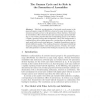Free Online Productivity Tools
i2Speak
i2Symbol
i2OCR
iTex2Img
iWeb2Print
iWeb2Shot
i2Type
iPdf2Split
iPdf2Merge
i2Bopomofo
i2Arabic
i2Style
i2Image
i2PDF
iLatex2Rtf
Sci2ools
ESANN
2008
2008
The gamma cycle and its role in the formation of assemblies
Rhythmic synchronization of activated neural groups in the gamma-frequency range (30-100 Hz) is observed in many brain regions. Interneuron networks are key to the generation of these rhythms. Motivated by the inhibitory effect of interneurons and summarizing experimental findings, it was recently proposed that the corresponding gamma cycle realizes a rapidly repeating winner-take-all algorithm. Here, this interpretation is considered from the modeling perspective, starting from an oscillatory network model with several stored patterns. A gradient formulation is used to include inhibitory pulses. The resulting dynamics is discussed, identifying temporal coding assemblies with coherent patterns. Thereby, the winnertake-all hypothesis is combined with binding-by-synchrony and confirmed.
Activated Neural Groups | Corresponding Gamma Cycle | ESANN 2008 | Inhibitory Effect | Neural Networks |
| Added | 29 Oct 2010 |
| Updated | 29 Oct 2010 |
| Type | Conference |
| Year | 2008 |
| Where | ESANN |
| Authors | Thomas Burwick |
Comments (0)

